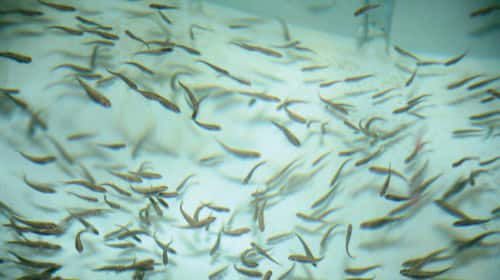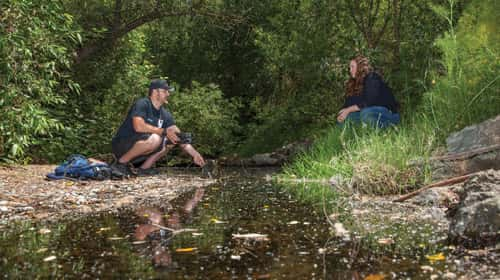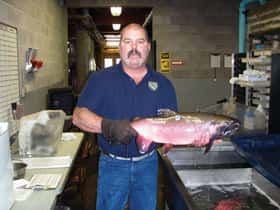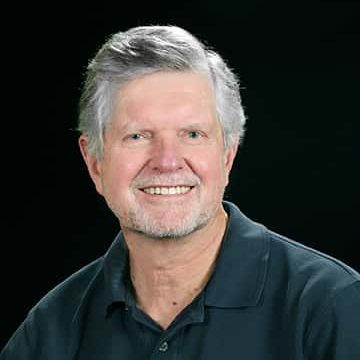
Thirty-five years ago a dedicated teacher and his Petaluma students set out to save the Adobe Creek native steelhead from extinction. Their resolve would be tested many times. Theirs would be a journey of celebration and heartbreaking setbacks. The story of the Casa Grande High School Fish Hatchery is one of resilience, and unrelenting determination.
It all began when wildlife biology teacher, Tom Furrer, led a classroom discussion on endangered species. At the board he listed seemingly insurmountable conservation and environmental issues the species faced. A concerned student raised his hand, “You’ve given us the problems, where are the solutions? What can we do to help?” Furrer was stunned. The question was legitimate; yet he had no answers. After class and deep in thought, Furrer walked across the road to Adobe Creek. As he made his way along the bank he spotted a rusted car hulk half-buried in the dry creek bed. He turned around and walked the other way. He encountered debris everywhere. Further on he met an elderly man with a bucket desperately trying to rescue young steelhead trapped in a shrinking pool of water. Furrer rushed to help. “I’ve lived alongside the creek all my life,” Charlie Malnati said. “When I was growing up, I used to watch steelhead pass through the backyard. What a thrill that was.” He turned his attention back to the baby fish struggling to survive.
Inspired by the encounter with Malnati, Furrer spent two years exploring the watershed. Afterwards, he launched “The Adobe Creek Restoration Project,” an undertaking intended to save the native steelhead genetic strain and restore the seven-mile creek habitat. He hoped the project would show students they could make a difference. The stakes were high, the chances of success not good. In 1880, the City of Petaluma diverted the creek’s water into a reservoir. That decision had taken its toll. A year after Furrer launched his project, community and state officials declared the creek “dead.” The decline was irreversible, they implied.
Students formed a club—the United Anglers of Casa Grande High School. They adopted the creek and a massive cleanup ensued. Tons of illegally dumped stoves and refrigerators, car parts and old engines, cans and bottles, and mounds of trash were hauled away. To prevent erosion and provide shade over potential spawning pools, the students planted thousands of willow and redwood trees along the barren banks. A fund-raiser to convert an abandoned on-campus greenhouse to a student-operated fish hatchery netted more than $6,000. Furrer went to Alaska and volunteered at a hatchery to learn operational skills. Over the next four years, students rescued 2,000-baby steelhead.
Encouraged by their success, the Casa Grande students took on an even bigger challenge dubbed Project Blue Water. That endeavor involved an extensive long-term study of Petaluma’s water usage. Research revealed that less than 2 percent of the diverted creek reservoir water was actually being used by the city. The students presented their data to the city council requesting that the creek water diversion be stopped. The council adamantly denied the request. Meanwhile problems for the hatchery mounted. The school board determined that the converted greenhouse failed to meet earthquake standards and was unsafe. The hatchery was closed.
Kicking into gear
Chastened, the students gathered in a classroom. One of them, a drafting student, went to the board and sketched out a plan for a new facility. The high school’s drafting class finalized the drawings. A local architect provided an estimate of construction cost—$510,000. On hearing that astronomical amount, most would have despaired, but not the students. Undeterred, they launched an all out fund-raising effort. And to facilitate this, United Anglers evolved from a club to nonprofit status. Even the fish cooperated. Amid much fanfare, students and community supporters lined the creek as 21 of the steelhead released about four years earlier returned to the creek’s now clear, clean waters to spawn. The following year five Chinook salmon showed up, the first documented evidence in a century.
Invigorated by the fish sightings, the fundraiser kicked into high gear. Students wrote more than 65 grant applications. Peter Pfendler, a Petaluma millionaire environmentalist, stopped by the school to congratulate the students and surprise Furrer with a check for $180,000. When student Julie Lambert gave an impassioned plea to 400 attendees at the Santa Rosa Veterans Memorial Building, six-year-old Jimmy Smithson climbed the stairs and walked across the stage to the podium. He handed Lambert a crumpled dollar bill. “Please make sure there are fishes when I grow up,” the young boy said. The pair embraced and Lambert burst into tears.
In the midst of the fundraising drive, the student’s resolve was tested. The Sonoma County Water Agency (SCWA) bulldozed 200 redwoods planted along the creek by United Anglers three years prior. Valuable shade area was destroyed. And though SCWA vowed to remedy the mistake, they never did. Students replanted the trees.
 Though the students were operating without a hatchery, they were not idle. Weekly they monitored Petaluma’s seven creeks for flow rate, temperature, any fish noted, and a water sample taken to determine health and oxygen levels. The data was shared with DFW and other agencies, and used by the students for year-to-year comparison of changes and impact. The weekly creek monitoring practice continues today.
Though the students were operating without a hatchery, they were not idle. Weekly they monitored Petaluma’s seven creeks for flow rate, temperature, any fish noted, and a water sample taken to determine health and oxygen levels. The data was shared with DFW and other agencies, and used by the students for year-to-year comparison of changes and impact. The weekly creek monitoring practice continues today.
Despite the city’s rejection years earlier, United Anglers again turned its attention to Project Blue Water. Students began a massive campaign requesting that officials stop diverting Adobe Creek water. “Let the creek heal” became a rallying cry. Further research uncovered crucial information that would prove vital to the student’s cause. The city reservoir had been constructed on a fault line. In an earthquake, the reservoir could potentially collapse sending a wall of water cascading down into the streets of Petaluma. The city council relented. And as nature intended, the waters of Adobe Creek again flowed down the slopes of Sonoma Mountain.
National attention
Five years after they began, United Anglers reached its goal of $510,000 and a state-of the-art fish hatchery was constructed on campus. At the opening ceremony, proud students held a banner with their motto: Together We Stand, Together We Dream, Together We Will Change The World.
United Anglers successes began to attract national attention. “ESPN Outdoors” produced the first of four documentaries. Renowned primatologist and environmentalist Jane Goodall visited the hatchery. Impressed by all that had been accomplished, Goodall would often mention the kids of Casa Grande in her global talks on the environment and saving endangered species. News of the high school’s success reached Japan. Casa Grande’s story was included in a textbook used in the nation’s public schools.
And then, a disaster. One of the school’s main electrical transformers exploded, causing a major power outage. The hatchery back-up generator operated for 72 hours, then failed. Students monitored systems day and night for 43 days until power was restored.
While rebounding from that disaster, another occurred. A developer installed a by-pass channel in Adobe Creek killing 12 steelhead and dumping four feet of silt over three miles of fish-rearing habitat. Student evaluation of the project had predicted this catastrophe as a possibility. Their warnings went unheeded, and subsequent cries for help and determination of financial responsibility were ignored. Unable to afford legal counsel, the students documented the adverse effects of the developer’s channel, an obstacle that still remains in place.
In 2003, the hatchery celebrated 20 years of operation. That year, more than 60 adult Chinook salmon returned to Adobe Creek, the largest return to date.
The student’s celebration was to be short lived. Operating under the auspices of flood control, an unsupervised SCWA work crew cut down rows of 20 year-old student-planted trees. This followed the year’s earlier incident where the 200 redwoods were destroyed. Community and student response was explosive. Following this mishap, SCWA instigated new measures to ensure protection of the fish habitat. SCWA is now a United Angler supporter and sponsor.
The end of an era
 After 30 years of inspiring students and launching The Adobe Creek Restoration Project, beloved teacher Furrer retired. He redirected all praise. “The kids in the project have won more than 30 international, national and state awards. They earned every one of them.” Furrer’s protégée and United Angler alumni Dan Hubacker stepped in to head the program. “Growing up in Petaluma, I spent a lot of time in the creeks,” Hubacker says. “I’d bring home frogs and insects to show my parents. Then in high school I heard about the fish program. I became Tom’s shadow. I volunteered for every job. And though I found school difficult, working with Tom and getting involved in the hatchery inspired me.” Hubacker went on to attend Santa Rosa Junior College and Sonoma State University where he graduated with a bachelor’s degree in environmental science. He followed that with further studies to obtain his teaching credentials.
After 30 years of inspiring students and launching The Adobe Creek Restoration Project, beloved teacher Furrer retired. He redirected all praise. “The kids in the project have won more than 30 international, national and state awards. They earned every one of them.” Furrer’s protégée and United Angler alumni Dan Hubacker stepped in to head the program. “Growing up in Petaluma, I spent a lot of time in the creeks,” Hubacker says. “I’d bring home frogs and insects to show my parents. Then in high school I heard about the fish program. I became Tom’s shadow. I volunteered for every job. And though I found school difficult, working with Tom and getting involved in the hatchery inspired me.” Hubacker went on to attend Santa Rosa Junior College and Sonoma State University where he graduated with a bachelor’s degree in environmental science. He followed that with further studies to obtain his teaching credentials.
For many years the hatchery operated under a permit granted by the California Department of Fish and Wildlife (DFW). The license allowed the students to catch and spawn Chinook. The students spawned Chinook at the hatchery, incubated the eggs, raised the young, performed coded wire tagging and clipped a fin for identification and genetic testing. Afterwards they would take Chinook to holding pens in San Francisco Bay for fresh to salt water acclimatization and release.
Animal rights activist, misunderstanding the need for the pens, once cut the nets releasing the fish prematurely. The incident created a public uproar and was broadcast on national news. Despite that unfortunate incident, United Angler would go on to raise and release more than 80,000 Chinook salmon into the bay. And then that came to an end.
 Concerned about possible genetic issues with so few returning adult Chinook in Adobe Creek, and the potential for wandering strays from other river basins, DFW revoked Casa Grande’s license to raise Chinook leaving the students with a state-of-the art hatchery and no fish. Fortunately Warms Springs Hatchery at Lake Sonoma came to the rescue. “We really wanted the students to continue their hands-on education,” says Brett Wilson, senior Hatchery supervisor, California DFW. “I visited their facility and was incredibly impressed. Their hatchery has all the capabilities we have at Warm Springs. And over the years we had gotten to know the students. They’ve volunteered or helped out as seasonal aides at Warms Springs. They’re dedicated and professional. A partnership seemed like a natural fit. Now the Casa Grande program is an extension of what we do at the Warms Springs Hatchery.“
Concerned about possible genetic issues with so few returning adult Chinook in Adobe Creek, and the potential for wandering strays from other river basins, DFW revoked Casa Grande’s license to raise Chinook leaving the students with a state-of-the art hatchery and no fish. Fortunately Warms Springs Hatchery at Lake Sonoma came to the rescue. “We really wanted the students to continue their hands-on education,” says Brett Wilson, senior Hatchery supervisor, California DFW. “I visited their facility and was incredibly impressed. Their hatchery has all the capabilities we have at Warm Springs. And over the years we had gotten to know the students. They’ve volunteered or helped out as seasonal aides at Warms Springs. They’re dedicated and professional. A partnership seemed like a natural fit. Now the Casa Grande program is an extension of what we do at the Warms Springs Hatchery.“
“Initially, we were disappointed we couldn’t continue our work of spawning Chinook,” Hubacker says. “But the arrangement we have with Warm Springs provides us with long-term opportunities. And it brings us back to our roots of saving the endangered steelhead.”
United Anglers continues its involvement with the Chinook through a DFW scientific collection permit. In the fall, students wade into the murky waters at the mouth of the Petaluma River to net returning 10 to 40 lb. Chinook. They measure length, record the weight, clip a fin for DNA analysis and identification, and release. The tracking data is provided to the DFW.
The Chinook journey
And in January, Casa Grande students trek to the Warm Springs Hatchery where they artificially spawn returning steelhead, a process that does not harm the fish. Afterwards they head back to their Petaluma hatchery with a cooler containing 15,000 to 20,000 eggs. The eggs are allocated so that each student is responsible for a tray with 500 to 1,000 eggs. The trays are placed in a dark, quiet incubation room where they’re nourished by a constant flow of filtered well water. After two weeks, students begin checking their trays daily, including weekends. They monitor egg development and record hatch rates. Unfertilized eggs and those that died are removed. Eventually the trays are submerged in a trough where the young float free. Over the next two months, the fry grow to become fingerlings and are transferred into one of four 3,000-gallon concrete raceways. The fish are fed, weighed and monitored by the students. In May, a DFW pathologist comes to check the health of the fish. Once the fish are certified, students truck the fingerlings back to Warm Springs where they are placed in rearing tanks for eight months. On release into Dry Creek, the steelhead begin a three- to four-year journey that will take them thousands of miles. The trip is fraught with peril. Ravenous bears, swooping eagles and the nets of fishermen lie in wait. Only one percent will manage to return to the waters of their birth. Back at the Warm Springs Hatchery they will spawn and renew the cycle of life.
“My son Joe graduated from the program in 2007,” says Bob Costarella, president of the United Angler’s Board of Directors. “United Anglers provides students with the skills and responsibilities needed to help run a fish hatchery and work in the environmental science field. The hatchery’s annual operating budget is $130,000. The kids help raise a big portion of this budget. It comes from donations, grants and an annual fundraiser that students help put on. This year’s event will be on Saturday, Nov. 3 at Petaluma’s Lucchesi Park Community Center. This event is always a lot of fun.”
Casa Grande junior Rachel Lucine is active in the hatchery program. “My dad’s a sports fisherman. He wanted me to get involved in the hatchery. I wasn’t that keen. I did it to make him happy,” she says with a laugh. “Now I love it. What we do here makes a difference. And I want to make a difference in my life.” Lucine has responsibility for the “Steelhead in Classroom” elementary school program. It covers 11 classrooms at nine Petaluma schools. Each class has an aquarium with 30 eggs provided by Warm Springs Hatchery. United Anglers provides the young students with fun instructional materials to help them understand the fish life cycle. Following a tour of the hatchery, the elementary students participate in activities and games. And they become pen pals with high school counterparts. The Casa Grande students initiate a letter to their elementary school partners inquiring about pets and what they are doing in school. The responses roll in. “I have a black cat named Blackberry and two dogs,” says one. “My favorite part of rising [raising] the fish is watching them hatch,” says another. And “P.S. I am kind of popular in my school.”
 Ellie Slick, a Casa Grande graduate, is a sophomore at Oregon State University majoring in fisheries and wildlife science. “As a college freshman, the hands-on experience I got with United Anglers provided me with knowledge and experience that juniors and seniors were just acquiring,” she says. “Those credentials helped me get an international internship. That was unusual for a freshman. I spent a summer in Malaysia Borneo at the Wildlife Rescue Unit. There I worked with sea turtles, and orphaned pygmy elephants and orangutans.” Slick acquired her interest in fish and mammals through a fourth grade junior anglers program and 4H. Following graduation from Oregon State, Slick hopes to get her master’s degree followed by a Ph.D. “I’d like to go into research and interact between science and the community.” Slick will be following in the footsteps of other notable Casa Grande hatchery alumni: Julie Mangada Lambert, formerly with the Buck Institute, has degrees in microbiology and molecular medicine; Anna Kastner is manager of Feather River Fish Hatchery; James Philips and Wes Stokes are biologists with DFW.
Ellie Slick, a Casa Grande graduate, is a sophomore at Oregon State University majoring in fisheries and wildlife science. “As a college freshman, the hands-on experience I got with United Anglers provided me with knowledge and experience that juniors and seniors were just acquiring,” she says. “Those credentials helped me get an international internship. That was unusual for a freshman. I spent a summer in Malaysia Borneo at the Wildlife Rescue Unit. There I worked with sea turtles, and orphaned pygmy elephants and orangutans.” Slick acquired her interest in fish and mammals through a fourth grade junior anglers program and 4H. Following graduation from Oregon State, Slick hopes to get her master’s degree followed by a Ph.D. “I’d like to go into research and interact between science and the community.” Slick will be following in the footsteps of other notable Casa Grande hatchery alumni: Julie Mangada Lambert, formerly with the Buck Institute, has degrees in microbiology and molecular medicine; Anna Kastner is manager of Feather River Fish Hatchery; James Philips and Wes Stokes are biologists with DFW.
Escaping extinction
Previously, the course taught by Furrer and Hubacker was an elective limited to 20 students in a school year. With the encouragement and support of the Sonoma County Office of Education, Hubacker reworked the curriculum. He sought UC recognition of the program as a lab science. Accreditation was approved in 2016. Now with biology as a perquisite, the environmental conservation and restoration course is open to juniors and seniors. Instead of only being available to 20 students, 160 have enrolled for the coming school year.
“There is no other course like this in the country,” Hubacker says. “And though we have had many successes over the years, our work is not yet done.” A Technical Oversight Committee has been formed to undertake an extensive study of not only Adobe Creek, but all the Petaluma creeks. The committee consists of marine biologists, representatives from DFW, the hatcheries and the community. The purpose is to better understand the watershed and ensure the survival of the native steelhead. “It’s exciting to think that a species long under threat could be saved from extinction during my lifetime,” says Hubacker. “That would be the ultimate game changer.”
Hatchery History
1880- City of Petaluma diverts Adobe Creek water to reservoir.
1982- High school biology teacher Tom Furrer undertakes two-year study of Petaluma watershed. Launches “The Adobe Creek Restoration Project.”
1983- Adobe Creek deemed “dead” by community and state officials.
1984- Students form United Anglers of Casa Grande High School and adopt Adobe Creek. Massive cleanup begins.
1985- Students plant thousands of trees along creek banks to restore fish habitat.
1986- Fund-raiser nets $6,000. Abandoned on-campus greenhouse converted to student-operated fish hatchery.
1987- 2,000-baby steelhead rescued from shrinking summer pools. Students undertake study of city water usage and discover less than 2 percent of reservoir water being used. Request to city council to stop diverting water is denied.
1988- School board determines on-campus hatchery does not meet earthquake standards. Hatchery closed. $510,000 required for new hatchery. Students begin fund-raiser.
1989- Twenty-one of student-raised steelhead return to Adobe Creek to spawn.
1990- Five Chinook salmon return for first time in a century.
1992- Oldest redwoods planted by students dug up and carted off by vandals.
1992- Students study reveals reservoir built on fault line. City discontinues diverting Adobe Creek water.
1993- Goal of $520,000 attained. On-campus, state-of the-art hatchery opens to celebration.
1998- Main school transformer explodes. Back-up hatchery generator fails. Students monitor systems 24/7 for 43 days until power restored.
1999- Developer constructs creek by-pass channel dumping four feet of silt over three miles of fish habitat. 12 steelhead killed.
2002- Record 74 Chinook salmon return to Adobe Creek.
2003- SCWA cuts down twenty-year old student planted trees in name of flood control. Students replant trees.
2010- United Angler’s founder Tom Furrer retires. Alumni Dan Hubacher takes over.
2011- Year-to-date, students raise and release over 80,000 Chinook into San Francisco Bay. Efforts thwarted when vandals cut nets prematurely releasing fish.
2013- Students license for raising Chinook revoked. Partnership started with DFW’s Warm Springs Hatchery to raise steelhead.
2016- Casa Grande High School Environmental Conservation and Restoration course recognized as lab science. Receives UC accreditation. 160 students enroll.





